Christ Church Kindergarten and Preschool
by Michael M. Black, Ed.D.
Posted March 3, 2021
Christ Church, Valdosta, has provided developmentally and educationally appropriate preschool education to hundreds of children over the past six decades. This service has been performed by a series of gifted, dedicated professionals. A testament to their work is the fact that so many of those fortunate children have grown up to be not only leaders in our church but of our community as well. Here is the story of how Christ Church Kindergarten and Preschool developed, of how inspired parish leadership, supportive parish members, and loving teachers influenced young lives positively and ultimately the world we live in.
German educator Friedrich Fröbel opened the first kindergarten in 1837 in Blankenburg, Germany. The word ‘kinder’ means ‘children’ in German, and the word ‘garten’ means ‘garden’ in German. A kindergarten for German immigrants opened in Watertown, Wisconsin in 1856, and it was not long before the kindergarten movement spread through the American landscape. The first English language kindergarten began in 1860 in Boston, Massachusetts (A. S. Passe, Kindergarten in the Twenty-first Century, p. 42-43, St. Paul, MN: Redleaf Press).
The Diocese of Georgia identified Christ Church first as an unorganized mission, then an organized mission. Because its membership and local activity had grown so well, delegates at Diocesan Convention voted May 11, 1954 to admit Christ Church as a parish. This designation meant Christ Church could be self-supporting and could develop new outreach initiatives. Among the first actions taken, Bishop Middleton S. Barnwell assigned the Rev. Michael J. Kippenbrock (1903-1973), who was serving as vicar, to be the first rector (H. T. Malone, The Episcopal Church in Georgia 1733-1957, 1960). The members of Christ Church also realized that birth through age five are critical years in the development of a child, so they encouraged the vestry to support the establishment of a kindergarten program.
Christ Church Kindergarten
Kindergarten during the first half of the 20th century focused more on social development, but by the second half of the 20th century, greater academic preparation was included so that instruction would align kindergarten to primary grades. Particularly in the southeastern United States, private kindergartens were the norm, and access to kindergarten was afforded to those who had the financial means to pay tuition. Under the direction of Mrs. George W. Tayman, a weekday kindergarten began in September 1954. Mrs. Tayman, the former Mary Katrina Lane (Ashley) (1891-1974), was well-known in Valdosta, being a granddaughter of Valdosta pioneer Remer Young Lane (1826-1917) and former daughter-in-law of Valdosta pioneer and mayor Cornelius Raines Ashley (1858-1926). A few local churches such as First Methodist already operated a kindergarten, and there were several private kindergartens.
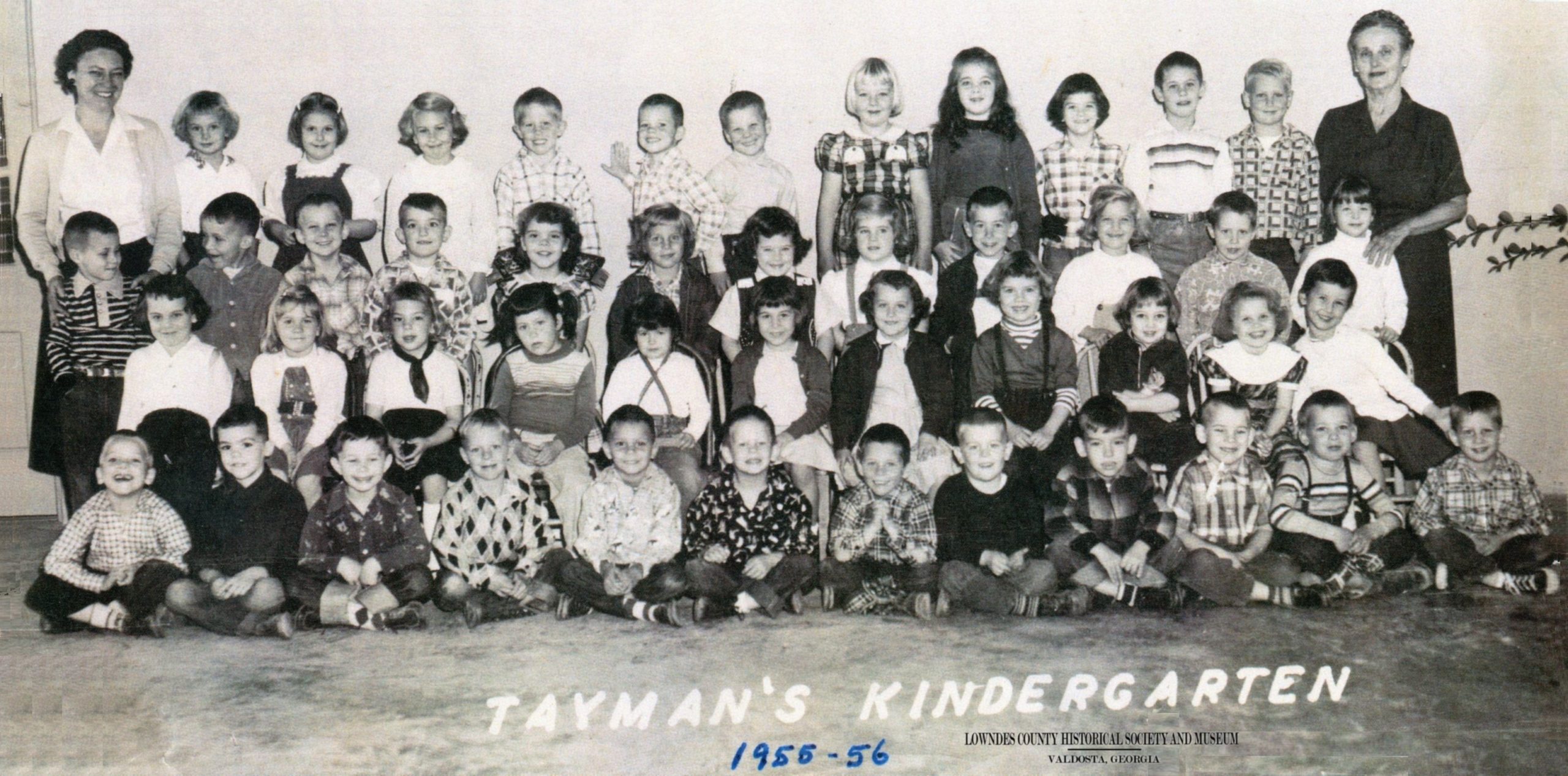
Katrina Tayman’s Kindergarten, 1955-56
Katrina Tayman’s Kindergarten, 1955-56
1st row: Gordon Sneed, Marvin Dickey, Bill Gandy, Carl ___, David ___, Keller Wilcox, David Wolf, Stan Coppage, Phillip ___, Johnny Perry, ___ Skipperer, Bob Bolton
2nd row: ___, Cindy ___, ____, Laurie ____, Tutter Bird, Marie DuPont, S. L. Davis, Kathy O’Hara, Kay ___, Helen Montague, Peggy Sikes
3rd row: Lane Giddens, David Drumheller, David Mann, Ronnie Krell, Debe Canaday, Kathy ___, Missy Allman, Shannon ____, Lee ___, Janice Ring, Neal Bethy, Rozzie Rutledge Bird
4th row: Lucille Dawson, Jill Chambers, Lynn Moseley, Carol McGraw, Hank Moseley, Buster Hodges, Joe Hall, Wilma Shelf, Teresa Sherwood, Seleste Conner, Harris Hines, Donnie ___, Katrina Tayman
Source: Lowndes County Historical Society and Museum
Former pupil, Marvin Dickey, recalled (summarized by the author):
It was quite a large class. There were students in the 4-5-6 age range. We were all in one room, which today is the front part of the Parish Hall. This was before the Parish Hall was extended. We always called her Mrs. Katrina. Mrs. Katrina’s assistant was Lucille Dawson. There was a brick wall separating the property line between the back of the church sanctuary and what is now the church office (103 East College). There was a playground right out back with a swing set and a metal seesaw. It was a half-day kindergarten where children were picked up at lunch.
Lucille Dawson Sineath recalled (summarized by the author):
My father, John “Jack” L. Dawson, was Sunday School superintendent which is most likely how my mother, Lucille Dawson, came to be an assistant teacher for Mrs. Tayman’s kindergarten. She worked there a few years. Katrina Tayman was a most interesting person in that if she thought it, she said it. There was a piano in the classroom, and Katrina played it every day. She could sit on the stool and play the piano while watching the children and encouraging them to sing out. They had a rhythm band where children played sticks, blocks, drums, triangles, and cymbals. Whenever Mrs. Tayman was in a group and the topic became low or depressing, she would say, “Well, let’s talk about Jesus!”
Katrina Tayman served a few years in this role and was succeeded by Vera Jean (Royal) Shirah (1917-1963) who taught until 1963. Enjoy reading Mrs. Shirah’s General Objectives for 1958-1959.
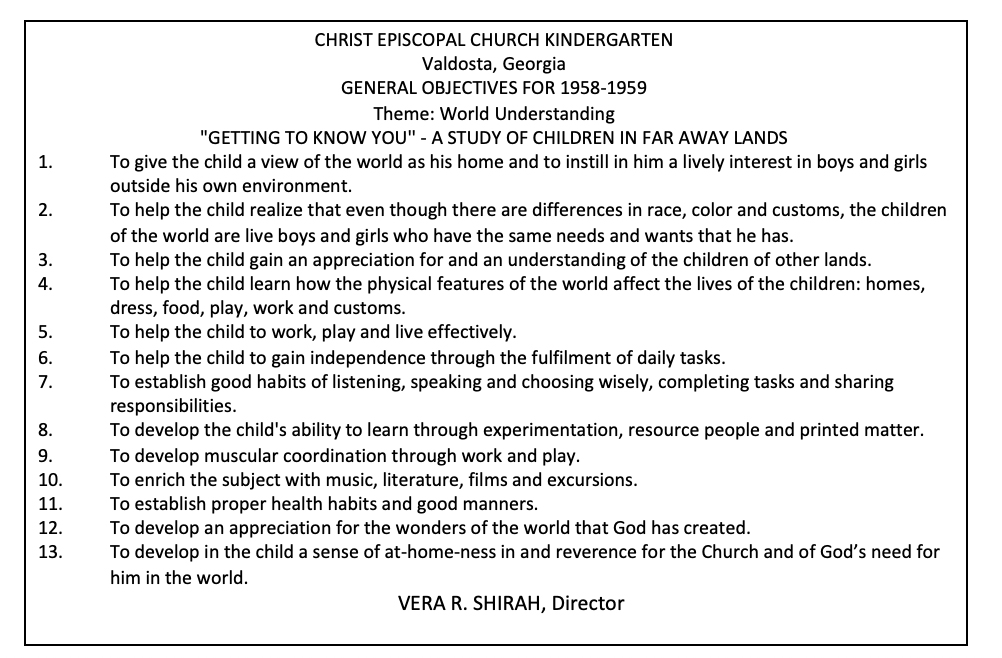
General Objectives, 1958-1959
With growing church membership, the vestry purchased the adjacent property at 103 East College Street in December 1958. The building was renovated to house Sunday School for students at the kindergarten level and lower school grades, and in December 1960, named Stuart Hall (in honor of the Right Rev. Albert R. Stuart, Sixth Bishop of Georgia). This building (in 2021) houses the church offices and choir room.
Shirah was succeeded by Florence “Teeny” Elizabeth Roddey (1917-1967) (Mrs. David C. Jr.) and assisted by Ruth Ann Roddey (helper) and Mary Wolinski (pianist). Others assisting with the kindergarten were Mrs. Jamie Carroll (1914-2003) and Mrs. Oliver B. Jackson (1920-2007). In Spring 1965, 14 students enrolled in the kindergarten paying $15.00 per month (Vestry Minutes, February 1965). The Rector, Brevard S. Williams, “personally observed the Kindergarten [and] praised its operation” (Vestry Minutes, March 16, 1965). Some of the routine monthly expenses of the kindergarten included Mrs. Roddey’s salary, assistants’ salaries, Vallotton’s Dairy, maid service, cookies, and American Education Publications for weekly readers. Mrs. Roddey ceased working with the kindergarten at the end of the 1965 session, and the vestry noted that her “many high ideals and natural affections for the children had a strong influence on the building of their character…” (Letter from H. T. Amon, Jr. to Mrs. D. C. Roddey, Jr., June 30, 1965).
Blackburn’s Kindergarten and Wood’s Kindergarten
With the departure of Mrs. Roddey, the Rector and Senior Warden identified Joella Blackburn and Ann Wood as tenants to rent the kindergarten space at a monthly rate of $75.00 (Vestry Minutes, April 11, 1965). A few days later, “Motion by Dr. [William M.] Gabard, seconded by Jamie Carroll and passed, authorized the discontinuance of the Kindergarten effective June, 1965, concurrent with the close of the present session” (Vestry Minutes, April 13, 1965). The remaining monies in the Kindergarten fund were moved to the Memorial Fund (Vestry Minutes, June 8, 1965). Although it initially appeared Christ Church was out of the kindergarten business, that was not the case. They formalized the rules and policies for Christ Church Kindergarten in 1966 (Vestry Minutes, May 9, 1966). The Rector and vestry kept a close watch on the kindergarten and maintained a separate kindergarten account, as reported in 13 subsequent years of vestry minutes.
Joella J. Blackburn (1930-2007) taught ten years in the kindergarten beginning in 1965 when the classroom was in Stuart Hall which was sometimes referred to as the Kindergarten Building. Her son, Chip Blackburn, donated a collection of pictures from her time at the kindergarten to the Lowndes County Historical Society and Museum. With the Museum’s permission, several of these photographs are shared below. Ann Wood taught the 4-year old class while Blackburn taught the 5-year old class.
• Blackburn’s Kindergarten – at Christmas [unknown year]
• Blackburn’s Kindergarten – Brookwood Park – March 23, 1967
• Blackburn’s Kindergarten – [unknown year]
• Blackburn’s Kindergarten – Ann Wood (left), Joella Blackburn (right), 1970
• Blackburn’s Kindergarten – [unknown year]
• Blackburn’s Kindergarten – field trip downtown to ride the train [unknown year]
• Blackburn’s Kindergarten – Halloween [unknown year]
• Blackburn’s Kindergarten – [unknown year]
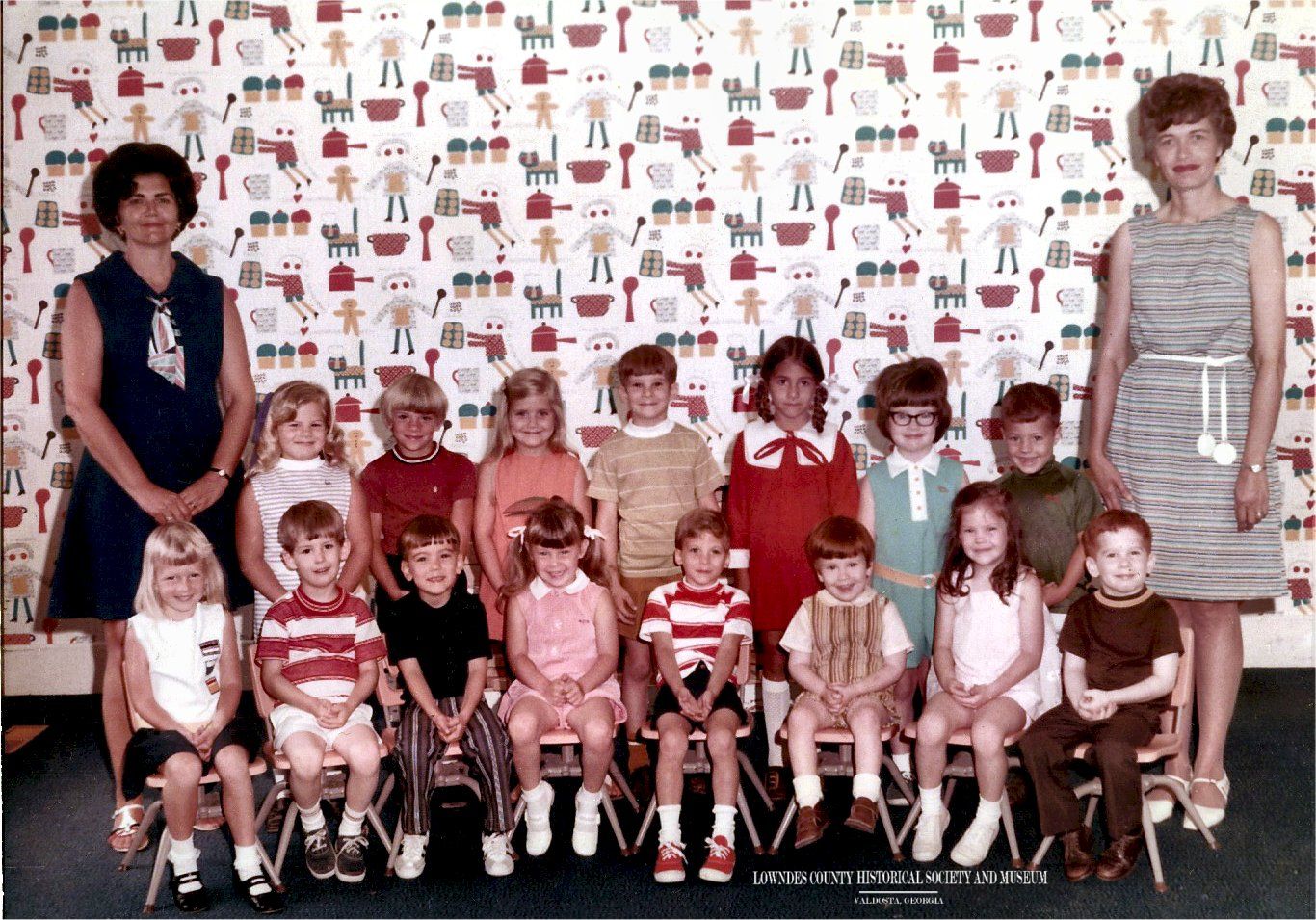
Christ Church Kindergarten, 1970.
Back row (five-year-old class): Ann Wood, -, -, -, -, -, Andrea Stevens, -, Joella Blackburn.
Front row (four-year-old class)
Source: Lowndes County Historical Society and Museum
Former pupil, Andrea Stevens Summervill, recalled (summarized by the author):
I had Mrs. Wood when I was four years old and Mrs. Blackburn when I was five years old. I have several distinct memories from kindergarten at Christ Church. As a four year old, I was nervous about starting school for the first time. Mrs. Wood let me bring my ‘bop’ to school and stored it in the cabinet. As long as I knew it was there, I was fine. I adored Mrs. Blackburn. She saw me and understood me. I loved playing in the sandbox. I remember finding a boulder on the playground one day and took it home. It turned out to be a chunk of concrete. We occasionally would walk all the way down to Brookwood Park to play. Before we went to the park, we all had to use the bathroom. The boy’s bathroom stunk which reinforced our thinking that boys were gross. There was a four-year old classroom on one side and a five-year old classroom on one side and then we could come together in the middle room for circle time. Our snack was Kool-Aid and butter ring cookies. One time I had to go to time-out; I stood in the corner and watched the fish in the aquarium. When it was time to leave at lunchtime, my mother drove through the alley behind the kindergarten and stopped at the large lantana bush to pick me up.
The Business of the Kindergarten
Publicly-funded kindergartens were introduced in the middle of the 20th century. President Johnson signed the Elementary and Secondary Education Act into law April 7, 1965, and the Act provided grants to school districts with students from low-income families. Kindergarten enrollment seemed to fluctuate from year to year. In Fall 1966, there were 17 students, but by Fall 1967, “42 children are enrolled in kindergarten…” (Vestry Minutes, September 13, 1966; September 11, 1967). The vestry recognized “that there were many children in the area who could be benefitted by attending kindergarten but can’t afford it. A motion was made and carried to offer 2 scholarships not to exceed $350.00 total for needy children of any faith…” (Vestry Minutes, March 11, 1968). The vestry also offered a $5.00 per month discount on tuition for active church members for the second and subsequent children in the kindergarten in the same year (Vestry Minutes, July 8, 1968). That fall “over half the pupils [were] members of the congregation, in contrast to last year when only about twenty percent of the student body were…” (Vestry Minutes, September 9, 1968). For the 1969-70 year, the kindergarten tuition was raised slightly to $23 per month (Vestry Minutes, April 13, 1969). The kindergarten enrollment for Fall 1970 dropped to 18 students, down from 42 the past year, so the vestry lowered the fee charged to Mrs. Blackburn to $50 per month (Vestry Minutes, September 21, 1970). CC kindergarten enrollment was 31 students in January 1973, up slightly from 25 students in January 1972 (Vestry Minutes, January 15, 1973). By 1975, the vestry became more concerned about “financial difficulties of our Kindergarten caused by low enrollment” (Vestry Minutes, March 17, 1975) and made the decision to close. In August 1977, the vestry “authorized the rector to negotiate terms with Mrs. Coleman” to use the kindergarten space as a nursery (Vestry Minutes, August 15, 1977).
Christ Church Preschool
The vestry had been working continuously to acquire additional property around the church by contacting neighbors (Vestry Minutes, January 17, 1972; July 17, 1972; September 18, 1972). In 1978, the vestry authorized an offer to purchase two adjacent properties to the south (1517 and 1519 N. Patterson St.) (Vestry Minutes, May 14, 1978). Negotiations continued for several months and in early 1979, the vestry authorized the Finance Committee to secure a loan up to $100,000 to finance the purchase (Vestry Minutes, February 26, 1979). These properties would later be named the Thomas Bray House and the Irene Miller House, and their acquisition would help to restart the Christ Church school. Some renovation occurred to both properties, and one was rented to Mrs. Probenda who operated a school. In early 1983, she notified Christ Church that her husband was being transferred, and the school would close at the end of the year (Vestry Minutes, February 21, 1983).
The Rev. Henry I. Louttit (1938-2020), Rector of Christ Church (1967-1994), desired to re-establish a preschool for 3 and 4 year olds. He envisioned the preschool as a form of mission outreach that would provide a rich learning experience for children in a happy, loving environment (and this purpose still guides the program today). A plan was presented to the vestry in 1983, noting that “such a school, employing two teachers, could be successfully operated and provide some income” (Vestry Minutes, February 21, 1983). A committee was immediately appointed to implement the program. Louttit also saw the practical side and knew that offering a preschool was not only a ministry for the church but could attract more families.
To prepare the building for opening, the vestry set out to remodel the Irene Miller House. By the end of summer 1983, “3 classrooms in Miller were now complete with new ceilings, carpet and wall paper, freshly painted trim” (Vestry Minutes, August 22, 1983). Christ Episcopal Preschool was re-established in 1983. The 4-year old preschool class opened with Marlin C. Ferrell as the instructor, and the 3-year old preschool class opened with Norma M. Tomberlin as the instructor.
The classes offered in 1983-84 proved successful. The tuition income that school year was $8,511 and $6,050 was spent on salaries, supplies, and utilities. The vestry approved remodeling the kitchen in the Miller House to accommodate a fourth classroom (Vestry Minutes, December 19, 1983). By 1985, the vestry authorized the Preschool Committee to raise tuition to $50 a month for the 1986-87 school year (Vestry Minutes, April 29, 1985).
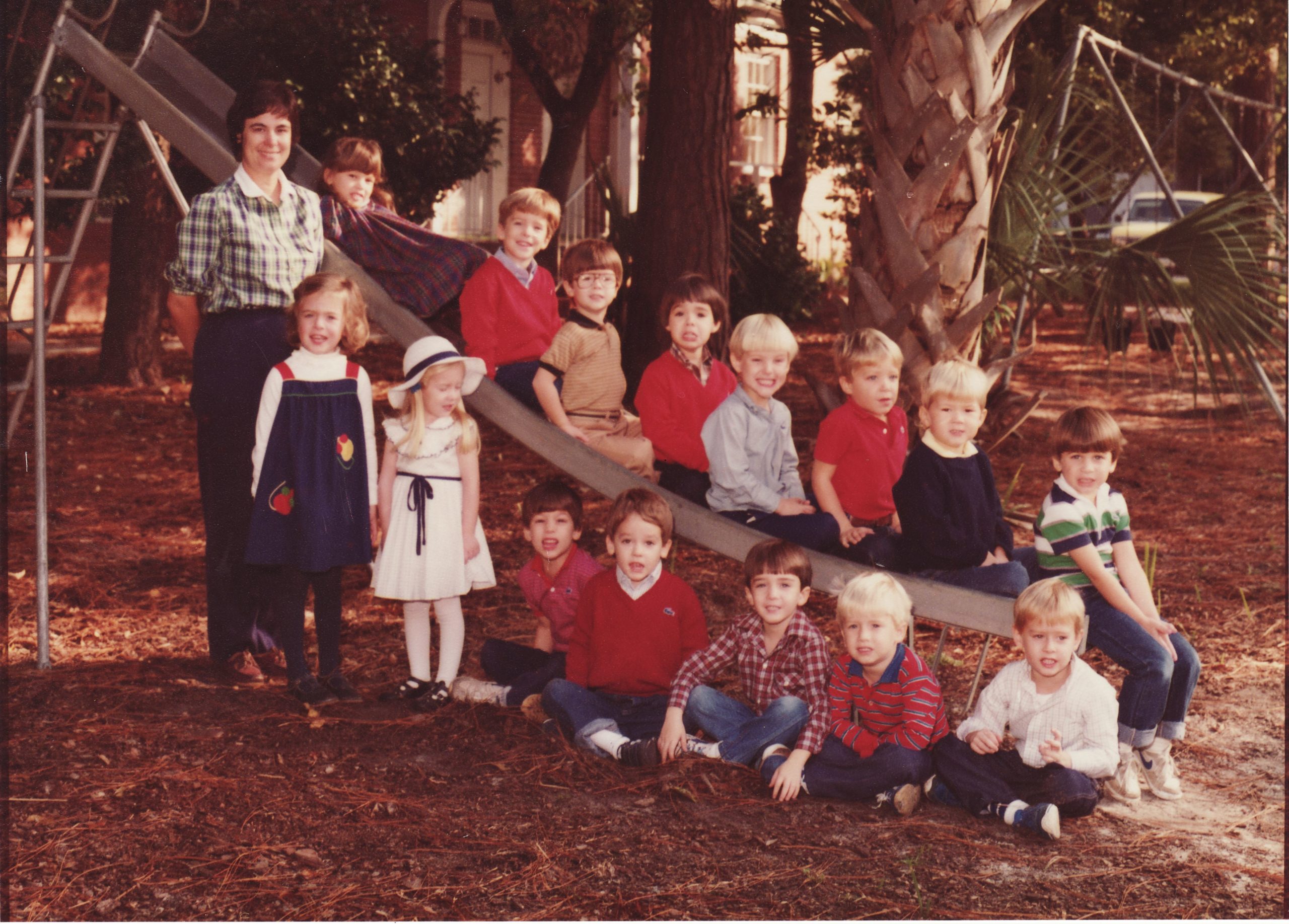
Marlin Ferrell’s 4-Year Old Preschool Class, Fall 1983
Marlin Ferrell’s 4-Year Old Preschool Class, Fall 1983
Slide: Meredith Munro, Walton Coleman, Michael Black, Stephen Lincoln, Jess Davis, David Drumheller, Andy Bishop, Andy Bolton
Front: Marlin Ferrell, Katherine Dasher, Lucy Barker, Bo Broadfoot, Justin Baker, Will Cunningham, Randy DeCoudres, Roger Budd; not pictured: Mac McLane
In 1959, Norma Lou Maxwell started school at Valdosta State College, moving here from Cairo. She lived in Ashley Hall, one of the residence halls for young ladies. Active during college, she was a member of the Sports Club, Kappa Delta Sorority, and Education Club, and secretary for the Student Government Association. She received the Marga and Mac Award for “Best All Round from the Senior Class.” She completed her Bachelor of Arts degree in English, with a minor in French, in 1963 and married Joseph A. Tomberlin (VSC Pinecone, 1960, 1961, 1962, 1963).
In 1977, she found her true passion: teaching preschool. She taught at Azalea City Baptist Church School (now Crossroads Baptist) from 1977 to 1983. She then transitioned to Christ Church Preschool. The preschool operated in the Irene Miller House for seven years before relocating to 109 East College Street in 1990 where it stayed for 22 years. While many of us have memories of Norma Tomberlin, a smile comes to my face when I recall seeing her lead a line of children on their morning walk, typically down the sidewalks around the church property.
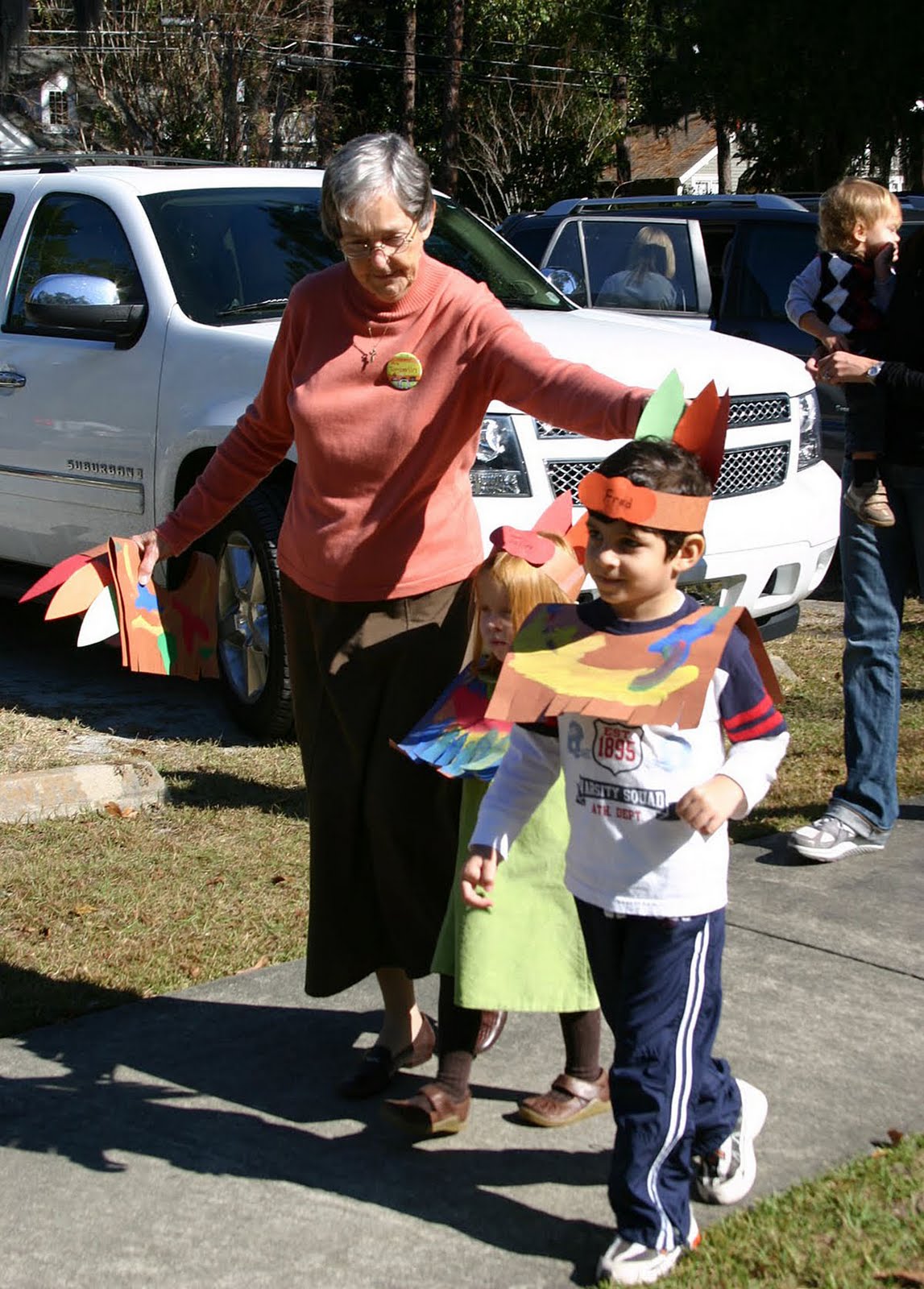
Norma Tomberlin leading preschoolers to the Thanksgiving Lunch, November 19, 2010
Mrs. Tomberlin retired from teaching preschool at Christ Church in 2000, and the vestry approved the naming of the preschool (109 East College) to be the Norma Tomberlin House in honor of her 29 years of dedicated service to Christ Church and the youth of Valdosta. Missing teaching, she returned in 2005 and continued teaching until 2013. Mrs. Tomberlin and her husband, Joseph A. Tomberlin, were faithful members of Christ Church and are interred in the memorial garden there.
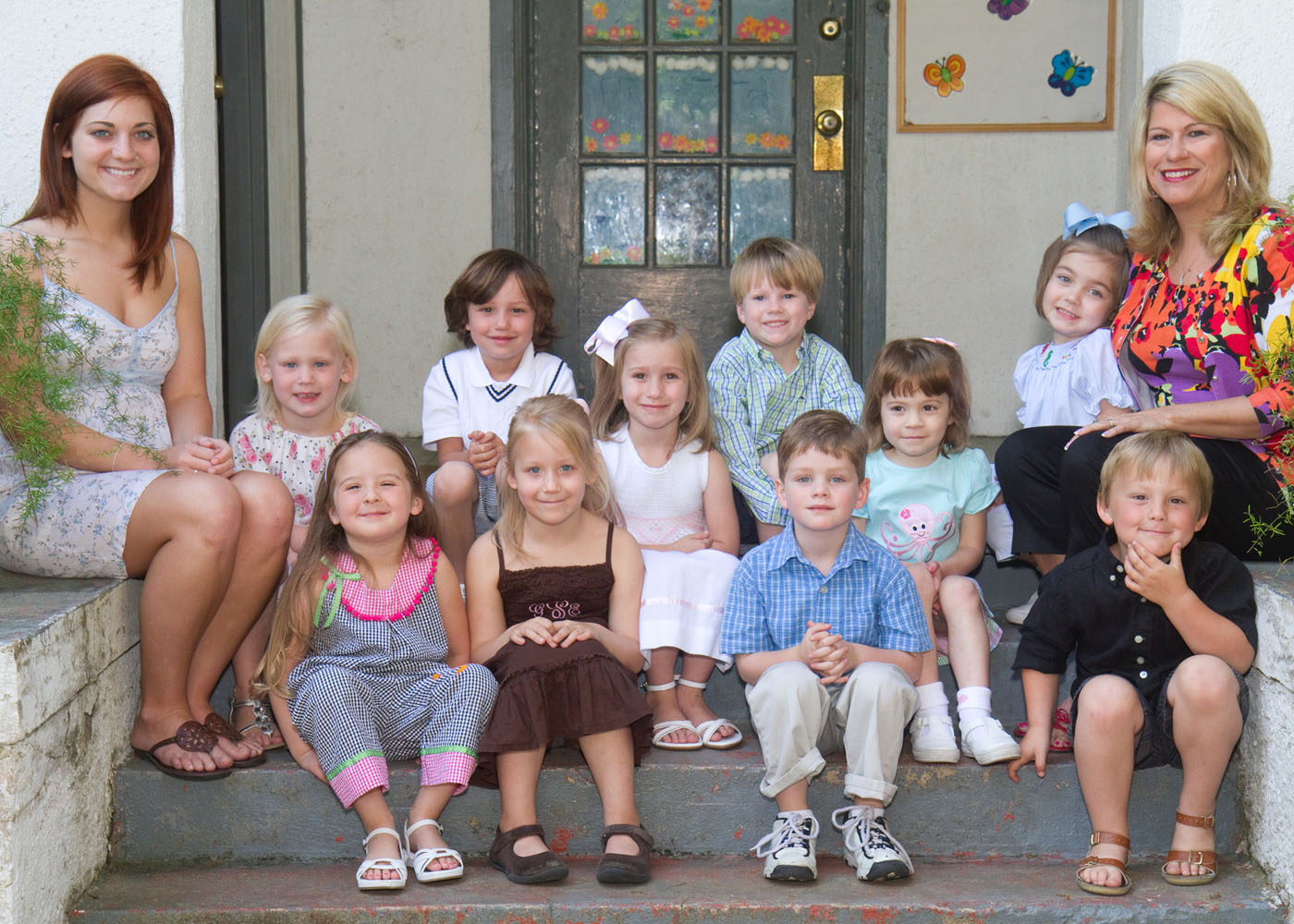
Elise Sandbach (far right) and assistant Patricia Greneker (far left) with their class on the steps of the Tomberlin House in 2010.
Elise Sandbach started teaching at Christ Episcopal Preschool in September 1992. Soon to complete her 29th year, she shared, “I have the best job in the world. I love the children. And I enjoy supporting parents. I have watched generations of kids grow up, and I am now teaching the children of children that I taught.” Remembering her friend and co-teacher, she continued, “Norma Tomberlin was the soul of the preschool. I think of her almost every day.”
At a retreat on March 17, 2007, the vestry established a Facilities Planning Committee. The Committee worked for five years on expansion of the physical plant, which resulted in plans for a new education building. In June 2009, the Leadership Lowndes Team No. 4 assisted Christ Church in relocating the historic Irene Miller House to make way for construction for a new education building (Vineyard, July 2009, p. 8). The Thomas Bray House was moved two years later (Vineyard, August 2011, p. 4). The William M. Gabard Education Building is a magnificent structure dedicated on the last Sunday in July 2012, Fr. Peter Ingeman’s final Sunday as Rector of Christ Church. Named for late educator and Christ Church member, William Montgomery Gabard, Ph.D. (1922-2006), it contains offices, a nursery, multipurpose rooms, kitchen, Sunday School classrooms, and preschool classrooms. [See Construction Photos of the Gabard Building]
Over the years, the preschool has been led by a Preschool Committee, the Rector, or the Assistant Rector. When the Rev. Dave Johnson arrived, he appointed Elise Sandbach as Director of the Preschool. The preschool temporarily closed in Spring 2020 due to COVID-19 and remained closed until January 2021. Jacque Thigpen, Barbara Selph, and Elise Sandbach are teaching one multi-age class in Spring 2021 and look forward to the time that they can safely reopen all the preschool classrooms. Although demand fluctuates, ideally the preschool will offer one 2-year old class for 3 days per week, one 2-year old class for 5 days per week, one 3-year old class for 5 days per week, and one 4-year old class for 5 days per week.
The family of Christ Church, Valdosta, extends tremendous gratitude to our current and former preschool teachers and to all those who have supported and continue to support this wonderful program. This author can be seen as a bespectacled, four-year old in the 1983 photograph of Mrs. Ferrell’s class. I remember so clearly her gentle ways, and I hear to this day Mrs. Tomberlin’s joyous, morning greeting: “Bonjour!”
Sincere thanks to all who have contributed memories or photographs which have been indispensable in the creation of this article. I invite you to submit any kindergarten/preschool memories or article corrections here.
Enjoy some of our preschool picture albums from past years. Thank you, Julia and Julius Ariail, for taking and posting these photographs:
• April 1, 2010 | Preschool Easter Hats
• May 3, 2010 | Preschool May Pole
• May 27, 2010 | Preschool Graduation
• October 29, 2010 | Preschool Halloween Parade
• November 19, 2010 | Preschool Thanksgiving
• October 30, 2011 | Preschool Halloween Parade
• October 4, 2011 | Preschool Fire Truck Visit
• May 26, 2011 | Preschool Graduation
• May 2, 2011 | Preschool Maypole
• October 31, 2012 | Preschool Halloween Parade
• May 23, 2013 | Preschool Graduation
• May 1, 2013 | Maypole
• May 16, 2017 | Preschool Graduation